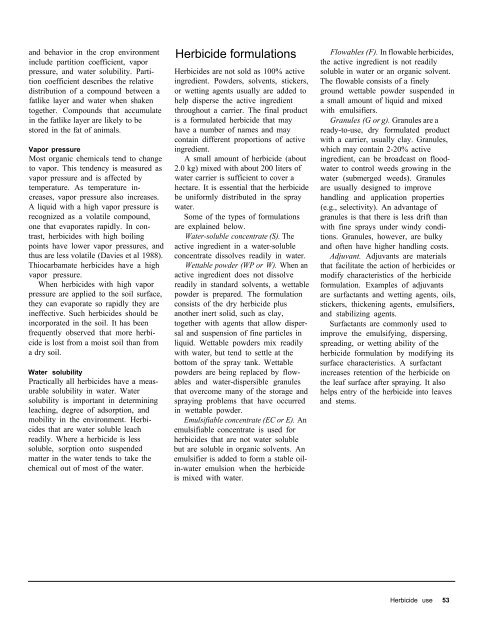A handbbok on Weed Control in Rice.pdf
A handbbok on Weed Control in Rice.pdf
A handbbok on Weed Control in Rice.pdf
You also want an ePaper? Increase the reach of your titles
YUMPU automatically turns print PDFs into web optimized ePapers that Google loves.
and behavior <strong>in</strong> the crop envir<strong>on</strong>ment<br />
<strong>in</strong>clude partiti<strong>on</strong> coefficient, vapor<br />
pressure, and water solubility. Parti-<br />
ti<strong>on</strong> coefficient describes the relative<br />
distributi<strong>on</strong> of a compound between a<br />
fatlike layer and water when shaken<br />
together. Compounds that accumulate<br />
<strong>in</strong> the fatlike layer are likely to be<br />
stored <strong>in</strong> the fat of animals.<br />
Vapor pressure<br />
Most organic chemicals tend to change<br />
to vapor. This tendency is measured as<br />
vapor pressure and is affected by<br />
temperature. As temperature <strong>in</strong>-<br />
creases, vapor pressure also <strong>in</strong>creases.<br />
A liquid with a high vapor pressure is<br />
recognized as a volatile compound,<br />
<strong>on</strong>e that evaporates rapidly. In c<strong>on</strong>-<br />
trast, herbicides with high boil<strong>in</strong>g<br />
po<strong>in</strong>ts have lower vapor pressures, and<br />
thus are less volatile (Davies et al 1988).<br />
Thiocarbamate herbicides have a high<br />
vapor pressure.<br />
When herbicides with high vapor<br />
pressure are applied to the soil surface,<br />
they can evaporate so rapidly they are<br />
<strong>in</strong>effective. Such herbicides should be<br />
<strong>in</strong>corporated <strong>in</strong> the soil. It has been<br />
frequently observed that more herbi-<br />
cide is lost from a moist soil than from<br />
a dry soil.<br />
Water solubility<br />
Practically all herbicides have a meas-<br />
urable solubility <strong>in</strong> water. Water<br />
solubility is important <strong>in</strong> determ<strong>in</strong><strong>in</strong>g<br />
leach<strong>in</strong>g, degree of adsorpti<strong>on</strong>, and<br />
mobility <strong>in</strong> the envir<strong>on</strong>ment. Herbi-<br />
cides that are water soluble leach<br />
readily. Where a herbicide is less<br />
soluble, sorpti<strong>on</strong> <strong>on</strong>to suspended<br />
matter <strong>in</strong> the water tends to take the<br />
chemical out of most of the water.<br />
Herbicide formulati<strong>on</strong>s<br />
Herbicides are not sold as 100% active<br />
<strong>in</strong>gredient. Powders, solvents, stickers,<br />
or wett<strong>in</strong>g agents usually are added to<br />
help disperse the active <strong>in</strong>gredient<br />
throughout a carrier. The f<strong>in</strong>al product<br />
is a formulated herbicide that may<br />
have a number of names and may<br />
c<strong>on</strong>ta<strong>in</strong> different proporti<strong>on</strong>s of active<br />
<strong>in</strong>gredient.<br />
A small amount of herbicide (about<br />
2.0 kg) mixed with about 200 liters of<br />
water carrier is sufficient to cover a<br />
hectare. It is essential that the herbicide<br />
be uniformly distributed <strong>in</strong> the spray<br />
water.<br />
Some of the types of formulati<strong>on</strong>s<br />
are expla<strong>in</strong>ed below.<br />
Water-soluble c<strong>on</strong>centrate (S). The<br />
active <strong>in</strong>gredient <strong>in</strong> a water-soluble<br />
c<strong>on</strong>centrate dissolves readily <strong>in</strong> water.<br />
Wettable powder (WP or W). When an<br />
active <strong>in</strong>gredient does not dissolve<br />
readily <strong>in</strong> standard solvents, a wettable<br />
powder is prepared. The formulati<strong>on</strong><br />
c<strong>on</strong>sists of the dry herbicide plus<br />
another <strong>in</strong>ert solid, such as clay,<br />
together with agents that allow disper-<br />
sal and suspensi<strong>on</strong> of f<strong>in</strong>e particles <strong>in</strong><br />
liquid. Wettable powders mix readily<br />
with water, but tend to settle at the<br />
bottom of the spray tank. Wettable<br />
powders are be<strong>in</strong>g replaced by flow-<br />
ables and water-dispersible granules<br />
that overcome many of the storage and<br />
spray<strong>in</strong>g problems that have occurred<br />
<strong>in</strong> wettable powder.<br />
Emulsifiable c<strong>on</strong>centrate (EC or E). An<br />
emulsifiable c<strong>on</strong>centrate is used for<br />
herbicides that are not water soluble<br />
but are soluble <strong>in</strong> organic solvents. An<br />
emulsifier is added to form a stable oil-<br />
<strong>in</strong>-water emulsi<strong>on</strong> when the herbicide<br />
is mixed with water.<br />
Flowables (F). In flowable herbicides,<br />
the active <strong>in</strong>gredient is not readily<br />
soluble <strong>in</strong> water or an organic solvent.<br />
The flowable c<strong>on</strong>sists of a f<strong>in</strong>ely<br />
ground wettable powder suspended <strong>in</strong><br />
a small amount of liquid and mixed<br />
with emulsifiers.<br />
Granules (G or g). Granules are a<br />
ready-to-use, dry formulated product<br />
with a carrier, usually clay. Granules,<br />
which may c<strong>on</strong>ta<strong>in</strong> 2-20% active<br />
<strong>in</strong>gredient, can be broadcast <strong>on</strong> flood-<br />
water to c<strong>on</strong>trol weeds grow<strong>in</strong>g <strong>in</strong> the<br />
water (submerged weeds). Granules<br />
are usually designed to improve<br />
handl<strong>in</strong>g and applicati<strong>on</strong> properties<br />
(e.g., selectivity). An advantage of<br />
granules is that there is less drift than<br />
with f<strong>in</strong>e sprays under w<strong>in</strong>dy c<strong>on</strong>di-<br />
ti<strong>on</strong>s. Granules, however, are bulky<br />
and often have higher handl<strong>in</strong>g costs.<br />
Adjuvant. Adjuvants are materials<br />
that facilitate the acti<strong>on</strong> of herbicides or<br />
modify characteristics of the herbicide<br />
formulati<strong>on</strong>. Examples of adjuvants<br />
are surfactants and wett<strong>in</strong>g agents, oils,<br />
stickers, thicken<strong>in</strong>g agents, emulsifiers,<br />
and stabiliz<strong>in</strong>g agents.<br />
Surfactants are comm<strong>on</strong>ly used to<br />
improve the emulsify<strong>in</strong>g, dispers<strong>in</strong>g,<br />
spread<strong>in</strong>g, or wett<strong>in</strong>g ability of the<br />
herbicide formulati<strong>on</strong> by modify<strong>in</strong>g its<br />
surface characteristics. A surfactant<br />
<strong>in</strong>creases retenti<strong>on</strong> of the herbicide <strong>on</strong><br />
the leaf surface after spray<strong>in</strong>g. It also<br />
helps entry of the herbicide <strong>in</strong>to leaves<br />
and stems.<br />
Herbicide use 53











